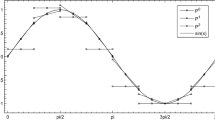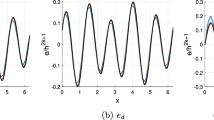Abstract
In this paper we present the local error estimate of Runge–Kutta discontinuous Galerkin (RKDG) methods with upwind-biased numerical fluxes for solving linear hyperbolic equations in one dimension with discontinuous initial data. Under the temporal–spatial condition to ensure the \(\hbox {L}^2\)-norm stability, the convergence orders in both space and time are optimal outside the pollution region due to the discontinuous initial data, whose width is nearly optimal to be one-half order of the mesh size, no matter in the upwind or the downwind direction. The kernel analysis is achieving the weighted \(\hbox {L}^2\)-norm stability result for the RKDG methods, based on the matrix transferring process and the local \(\hbox {L}^2\)-projection. Furthermore, we need to set up the weighted approximation property for the generalized Gauss–Radau projection. Finally some numerical experiments are also given to support the theoretical results.
Similar content being viewed by others
Data Availability
All data generated or analysed during this study are included in this published article.
References
Cao, W., Zhang, Z.: Some recent developments in superconvergence of discontinuous Galerkin methods for time-dependent partial differential equations. J. Sci. Comput. 77(3), 1402–1423 (2018). https://doi.org/10.1007/s10915-018-0762-2
Cheng, Y., Zhang, Q.: Local analysis of the local discontinuous Galerkin method with generalized alternating numerical flux for one-dimensional singularly perturbed problem. J. Sci. Comput. 72(2), 792–819 (2017). https://doi.org/10.1007/s10915-017-0378-y
Cheng, Y., Meng, X., Zhang, Q.: Application of generalized Gauss–Radau projections for the local discontinuous Galerkin method for linear convection-diffusion equations. Math. Comput. 86(305), 1233–1267 (2017). https://doi.org/10.1090/mcom/3141
Cockburn, B., Guzmán, J.: Error estimates for the Runge–Kutta discontinuous Galerkin method for the transport equation with discontinuous initial data. SIAM J. Numer. Anal. 46(3), 1364–1398 (2008). https://doi.org/10.1137/060668936
Cockburn, B., Shu, C.-W.: TVB Runge–Kutta local projection discontinuous Galerkin finite element method for conservation laws. II. General framework. Math. Comput. 52(186), 411–435 (1989). https://doi.org/10.2307/2008474
Cockburn, B., Shu, C.-W.: The Runge–Kutta local projection \(P^1\)-discontinuous-Galerkin finite element method for scalar conservation laws. RAIRO Modél. Math. Anal. Numér. 25(3), 337–361 (1991). https://doi.org/10.1051/m2an/1991250303371
Cockburn, B., Shu, C.-W.: The Runge–Kutta discontinuous Galerkin method for conservation laws. V. Multidimensional systems. J. Comput. Phys. 141(2), 199–224 (1998). https://doi.org/10.1006/jcph.1998.5892
Cockburn, B., Shu, C.-W.: Runge–Kutta discontinuous Galerkin methods for convection-dominated problems. J. Sci. Comput. 16(3), 173–261 (2001). https://doi.org/10.1023/A:1012873910884
Cockburn, B., Hou, S., Shu, C.-W.: The Runge–Kutta local projection discontinuous Galerkin finite element method for conservation laws. IV. The multidimensional case. Math. Comput. 54(190), 545–581 (1990). https://doi.org/10.2307/2008501
Cockburn, B., Lin, S.Y., Shu, C.-W.: TVB Runge–Kutta local projection discontinuous Galerkin finite element method for conservation laws. III. One-dimensional systems. J. Comput. Phys. 84(1), 90–113 (1989). https://doi.org/10.1016/0021-9991(89)90183-6
Cockburn, B., Luskin, M., Shu, C.-W., Süli, E.: Enhanced accuracy by post-processing for finite element methods for hyperbolic equations. Math. Comput. 72(242), 577–606 (2003). https://doi.org/10.1090/S0025-5718-02-01464-3
Johnson, C., Pitkäranta, J.: An analysis of the discontinuous Galerkin method for a scalar hyperbolic equation. Math. Comput. 46(173), 1–26 (1986). https://doi.org/10.2307/2008211
Johnson, C., Nävert, U., Pitkäranta, J.: Finite element methods for linear hyperbolic problems. Comput. Methods Appl. Mech. Eng. 45(1–3), 285–312 (1984). https://doi.org/10.1016/0045-7825(84)90158-0
Li, X., Ryan, J.K., Kirby, R.M., Vuik, K.: Smoothness-increasing accuracy-conserving (SIAC) filtering for discontinuous Galerkin solutions over nonuniform meshes: superconvergence and optimal accuracy. J. Sci. Comput. 81(3), 1150–1180 (2019). https://doi.org/10.1007/s10915-019-00920-7
Meng, X., Shu, C.-W., Wu, B.: Optimal error estimates for discontinuous Galerkin methods based on upwind-biased fluxes for linear hyperbolic equations. Math. Comput. 85(299), 1225–1261 (2016). https://doi.org/10.1090/mcom/3022
Shu, C.-W.: Discontinuous Galerkin methods: general approach and stability. In: Numerical Solutions of Partial Differential Equations. Advanced Mathematics Training Course, CRM Barcelona, pp. 149–201. Birkhäuser, Basel (2009). https://doi.org/10.1007/978-3-7643-8940-6
Shu, C.-W.: Discontinuous Galerkin methods for time-dependent convection dominated problems: basics, recent developments and comparison with other methods. In: Building Bridges: Connections and Challenges in Modern Approaches to Numerical Partial Differential Equations, pp. 369–397. Springer, Cham (2016). https://doi.org/10.1007/978-3-319-41640-3
Shu, C.-W., Osher, S.: Efficient implementation of essentially nonoscillatory shock-capturing schemes. J. Comput. Phys. 77(2), 439–471 (1988). https://doi.org/10.1016/0021-9991(88)90177-5
Xu, Y., Shu, C.-W., Zhang, Q.: Error estimate of the fourth-order Runge–Kutta discontinuous Galerkin methods for linear hyperbolic equations. SIAM J. Numer. Anal. 58(5), 2885–2914 (2020). https://doi.org/10.1137/19M1280077
Xu, Y., Zhang, Q., Shu, C.-W., Wang, H.: The L\(^2\)-norm stability analysis of Runge–Kutta discontinuous Galerkin methods for linear hyperbolic equations. SIAM J. Numer. Anal. 57(4), 1574–1601 (2019). https://doi.org/10.1137/18M1230700
Xu, Y., Meng, X., Shu, C.-W., Zhang, Q.: Superconvergence analysis of the Runge–Kutta discontinuous Galerkin methods for a linear hyperbolic equation. J. Sci. Comput. (2020). https://doi.org/10.1007/s10915-020-01274-1
Zhang, Q., Shu, C.-W.: Error estimates to smooth solutions of Runge–Kutta discontinuous Galerkin methods for scalar conservation laws. SIAM J. Numer. Anal. 42(2), 641–666 (2004). https://doi.org/10.1137/S0036142902404182
Zhang, Q., Shu, C.-W.: Stability analysis and a priori error estimates of the third order explicit Runge–Kutta discontinuous Galerkin method for scalar conservation laws. SIAM J. Numer. Anal. 48(3), 1038–1063 (2010). https://doi.org/10.1137/090771363
Zhang, Q., Shu, C.-W.: Error estimates for the third order explicit Runge–Kutta discontinuous Galerkin method for a linear hyperbolic equation in one-dimension with discontinuous initial data. Numer. Math. 126(4), 703–740 (2014). https://doi.org/10.1007/s00211-013-0573-1
Funding
The work of Y. Xu is partially supported by NSFC Grant 12071214 and Postgraduate Research and Practice Innovation Program of Jiangsu Province Grant KYCX21_0028. The work of D. Zhao is partially supported by NSFC Grants 12071214. The work of Q. Zhang is partially supported by NSFC Grants 12071214 and 11671199.
Author information
Authors and Affiliations
Corresponding author
Ethics declarations
Conflict of interests
The authors have no relevant financial or non-financial interests to disclose.
Additional information
Publisher's Note
Springer Nature remains neutral with regard to jurisdictional claims in published maps and institutional affiliations.
Appendix
Appendix
In this section we present the detailed proof of (4.9), where Cauchy–Schwarz inequality and Young inequality are the elemental tools.
The former five terms in (4.7) are easily bounded along the same line as in [19, 20]. Limited by the length of this paper, we only give a quick description below. In details,
Lemma 3.2 implies
Lemma 3.3 and the second inverse inequality in (3.2) yield
Since the matrix \(\{b_{ij}\}_{0\le i,j\le \zeta -1}\) is symmetric positive definite with the smallest eigenvalue \(\varepsilon >0\), we can additionally use the second inverse inequality in (3.2) to yield
Since \(\psi (x,t)=\psi _{\star }(x-\beta t)\) and \(\lambda \le 1\), we use the Taylor expansion together with assumptions W1 and W2 to get
which implies
However, the estimate to the last term \(\Pi ^n_6\) is a little difficult. Without losing generality, we assume that \(\psi ^n\) is monotone increasing and take \(\phi =\partial _x\psi ^n\) in (3.21). Based on the second strategy of the matrix transferring process (see Lemma 3.9), we have
where
Each term in (6.7) can be similarly bounded by using Cauchy-Schwarz inequality and Young inequality, with the additional help of
for \(\phi =\psi ^n\) or \(\phi =\partial _x\psi ^n\). Note that (6.8) follows from assumption W2.
The estimate to the first term \(\Pi ^n_{61}\) is kernel. Noticing the shallowing structure of the matrix \(\{p_{ij}\}\), we have
where \(\zeta \le r\) and \(\lambda \le 1\) are used at the last step. An application of (6.8) yields
Since \(\tau ^2\beta ^2=\tau \beta \lambda h=\lambda ^2h^2\), using the inverse inequality (3.2) to deal with the high order temporal information, we have
Using Lemma 3.2 with \(\phi =\partial _x\psi ^n\), we have
Using Lemma 3.3 with \(\phi =\partial _x\psi ^n\) and (6.8), we have
where the treatment for \(\Pi ^n_{62}\) have been also used here. Similarly, an application of (6.8) twice yields
Collecting the above inequalities into (6.6), we have the estimate
Now we are able to get the expected inequality (4.9) by summing up all estimates for the terms \(\Pi ^n_1\) through \(\Pi ^n_6\).
Rights and permissions
About this article
Cite this article
Xu, Y., Zhao, D. & Zhang, Q. Local Error Estimates for Runge–Kutta Discontinuous Galerkin Methods with Upwind-Biased Numerical Fluxes for a Linear Hyperbolic Equation in One-Dimension with Discontinuous Initial Data. J Sci Comput 91, 11 (2022). https://doi.org/10.1007/s10915-022-01793-z
Received:
Revised:
Accepted:
Published:
DOI: https://doi.org/10.1007/s10915-022-01793-z
Keywords
- Runge–Kutta discontinuous Galerkin method
- Upwind-biased
- Matrix transferring process
- Weighted stability analysis
- Local error estimate




